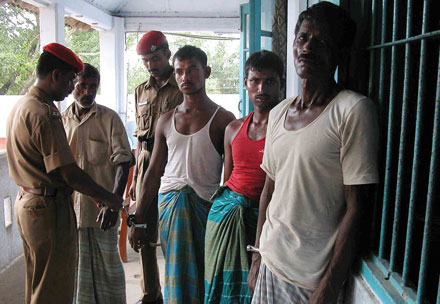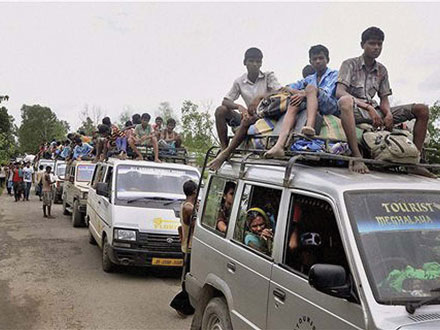Archives
Role of Minority Muslims in Assam Politics
The politics of Assam, no wonder, is also influenced by such socio – political issues as everywhere else in the country. Indeed it is widely speculated that this time the results of the Lok Sabha polls in the State which are going to be held in the country for 14 seats in April – May this year may be determined by the failure of the Government to keep at check the growing rise of prices, to fulfil the separate statehood demands or grant to give greater autonomy called for by diverse ethnic tribal communities because this has led to a cleft in the greater Assamese society.
 The politics of the settled minority Muslims in Assam (minus the indigenous Assamese Muslims) is a little different from the rest of the population in the State. In a State, whether or not there has been abnormal growth of population of a particular ethnic or linguistic or religious group is not always understandable from the number of seats their leaders win in an Assembly poll. However, in Assam, it can be almost presumable considering the number of Assembly seats the leaders of a community secure.
The politics of the settled minority Muslims in Assam (minus the indigenous Assamese Muslims) is a little different from the rest of the population in the State. In a State, whether or not there has been abnormal growth of population of a particular ethnic or linguistic or religious group is not always understandable from the number of seats their leaders win in an Assembly poll. However, in Assam, it can be almost presumable considering the number of Assembly seats the leaders of a community secure.
Here, the issue of our discussion pertains to the Bangladesh migrants’ role in State politics. Indeed, before initiating it in this regard, all we need to do is dig up their demographic growth. This is all the more important as it will enable us to draw a conclusion about how the Bangladeshi settlers gradually become an influential community in Assam politics.
It has been revealed that from 1911 to 1951, while the decadal variation at the All India level ranged from approximately 6% to 14%, the decadal variation in Assam, surprisingly, was on an average 20% till 1951. Between 1961 and 1971, the decadal variation in the State remained almost the same. This was 34.97% in 1961 and 34.95% in 1971 whereas in the All India level, it rose from 21.64% to 24.06% during the corresponding period. Prior to this, between 1951 and 1961, the decadal variation went up from 19.94% to 34.97% in Assam whereas, at the national level, it only rose from 13.31% to 21.64%. This speaks volumes about how, in each decade, the population was increasing in the State much faster than the national level growth. Immigration was one of the reasons for such population growth.
 It may be noted here that in the 1991 census, influx was recorded as the result of the extra – ordinary increase of settlers from undivided Bengal districts of Mymensingh, Pabna, Rajasahi and Khulna. The problem of influx first became conspicuous in 1911 and Assam has been facing the problem of immigration till India attained its independence in 1947. Thereafter, it became the problem of what is termed ‘Pak infiltration’. After the 1961 census, it was revealed that there had been an abnormal growth in the Muslim population and that their numbers was estimated at 12 million as per the census of India. There was a news report that appeared in a section of the print media at that time during the period 1951 – 61 that as many as 2,20,691 Pakistanis had infiltrated and stayed in the State as recorded in the Paper I of 1963 (Census of India) published by the Registrar General and the Census Commissioner of India which was revealed after an in – depth and thorough study.
It may be noted here that in the 1991 census, influx was recorded as the result of the extra – ordinary increase of settlers from undivided Bengal districts of Mymensingh, Pabna, Rajasahi and Khulna. The problem of influx first became conspicuous in 1911 and Assam has been facing the problem of immigration till India attained its independence in 1947. Thereafter, it became the problem of what is termed ‘Pak infiltration’. After the 1961 census, it was revealed that there had been an abnormal growth in the Muslim population and that their numbers was estimated at 12 million as per the census of India. There was a news report that appeared in a section of the print media at that time during the period 1951 – 61 that as many as 2,20,691 Pakistanis had infiltrated and stayed in the State as recorded in the Paper I of 1963 (Census of India) published by the Registrar General and the Census Commissioner of India which was revealed after an in – depth and thorough study.
For the people of Assam, one satisfying aspect of the whole story with regard to the Pak infiltrators however is that they were not allowed to overstay in the State. Their lodging was made purely temporary largely thanks to the late Bimala Prasad Chaliha, the then Chief Minister of Assam. It was primarily he who took the initiative and made serious efforts at sending them back, and this, interestingly, yielded desired results when out of 2,20,691 Pak intruders, 1,92,339 were deported between 1961 – 71 and the remaining 28,362 reportedly were sent back later from 1971 to November 1978.
 In the wake of this pleasing development, there was apprehension as to whether this would lead to any strong reaction among the immigrants in the State and whether they would try to capitalize on it during the anti foreigners’ stir spearheaded by the combined leadership of the ASSU – AGSP later known as the AGP from 1979 in the wake of SL Shakdher, the then Chief Election Commissioner of India and former Secretary – General of Lok Sabha making a mention of the problem of foreign nationals in the meeting of the Chief Electoral Officers at Ootacamund in 1978. In fact, it became a much – discussed topic in Assam in 1979 when the names of hundreds of suspected Bangladeshis were detected during the preparation of the electoral rolls necessitated for holding the by – elections in Mangaldoi Lok Sabha constituency following the sad and sudden demise of Hiralal Patwary. However, nothing as was feared had happened. Throughout the six year protracted mass movement, the minority leaders had kept mum. They did not raise any accusing finger at the authorities for deporting the Pak infiltrators. There were indeed a few valid reasons behind their maintaining a low profile. First was the mass State – wide agitation against foreign nationals which kept the political atmosphere charged while the second reason was possibly the very number of their elected representatives in the State Legislative Assembly being around 21 in a house of 114 which was much too meagre to pitch for a halt to the movement. Candidly speaking, maybe because their numbers was not too large to be qualified to get themselves involved in what is called ‘real minority politics’ or get in a bargaining position, they essentially desisted from doing any sort of politics presumably because most of the Bangladeshi immigrants were the traditional support of the Indian National Congress, now known as the Congress (I) as these people considered this outfit, till very recently, to be their only saviour.
In the wake of this pleasing development, there was apprehension as to whether this would lead to any strong reaction among the immigrants in the State and whether they would try to capitalize on it during the anti foreigners’ stir spearheaded by the combined leadership of the ASSU – AGSP later known as the AGP from 1979 in the wake of SL Shakdher, the then Chief Election Commissioner of India and former Secretary – General of Lok Sabha making a mention of the problem of foreign nationals in the meeting of the Chief Electoral Officers at Ootacamund in 1978. In fact, it became a much – discussed topic in Assam in 1979 when the names of hundreds of suspected Bangladeshis were detected during the preparation of the electoral rolls necessitated for holding the by – elections in Mangaldoi Lok Sabha constituency following the sad and sudden demise of Hiralal Patwary. However, nothing as was feared had happened. Throughout the six year protracted mass movement, the minority leaders had kept mum. They did not raise any accusing finger at the authorities for deporting the Pak infiltrators. There were indeed a few valid reasons behind their maintaining a low profile. First was the mass State – wide agitation against foreign nationals which kept the political atmosphere charged while the second reason was possibly the very number of their elected representatives in the State Legislative Assembly being around 21 in a house of 114 which was much too meagre to pitch for a halt to the movement. Candidly speaking, maybe because their numbers was not too large to be qualified to get themselves involved in what is called ‘real minority politics’ or get in a bargaining position, they essentially desisted from doing any sort of politics presumably because most of the Bangladeshi immigrants were the traditional support of the Indian National Congress, now known as the Congress (I) as these people considered this outfit, till very recently, to be their only saviour.
However, with the rapid growth of their numbers – 199 lakhs in 1981 and then 224 lakhs in 1991, a majority of their politicians started floating a new political outfit – the UMF to field their candidates and side by side, they put up nominees on the Congress tickets against those of the opposition parties in the 1996 Assembly polls in the State. The reason was all too evident – to play the role of what is termed – ‘king makers’. It is an altogether different story that in the election, the UMF of Golam Osmani garnered a mere two Assembly seats. However, in the current State politics, they can control the electoral verdict in as many as 60 of the State’s 126 Assembly segments thanks to the clout of Ajmal’s AAUDF formed just on the eve of the 2006 Assembly polls in Assam and that of an all India Muslim party like Jamiat - Ulema - E - Hind goes without saying, though it has no unit influencing them here.

